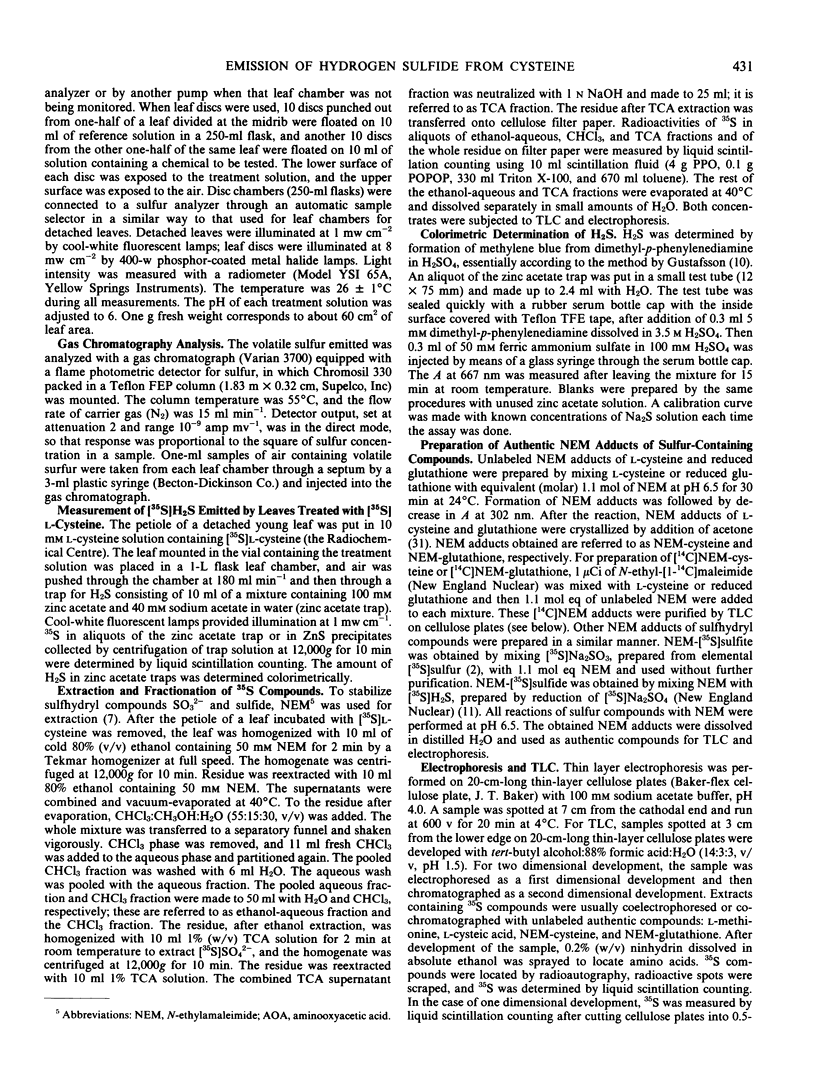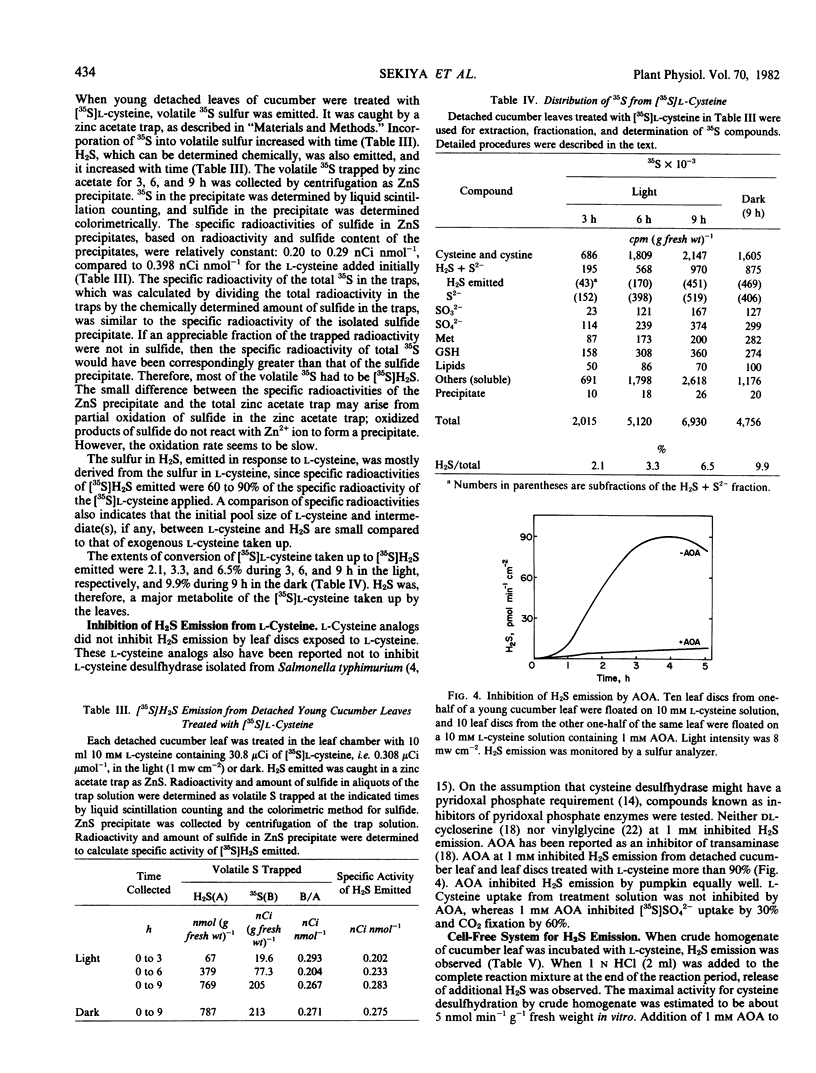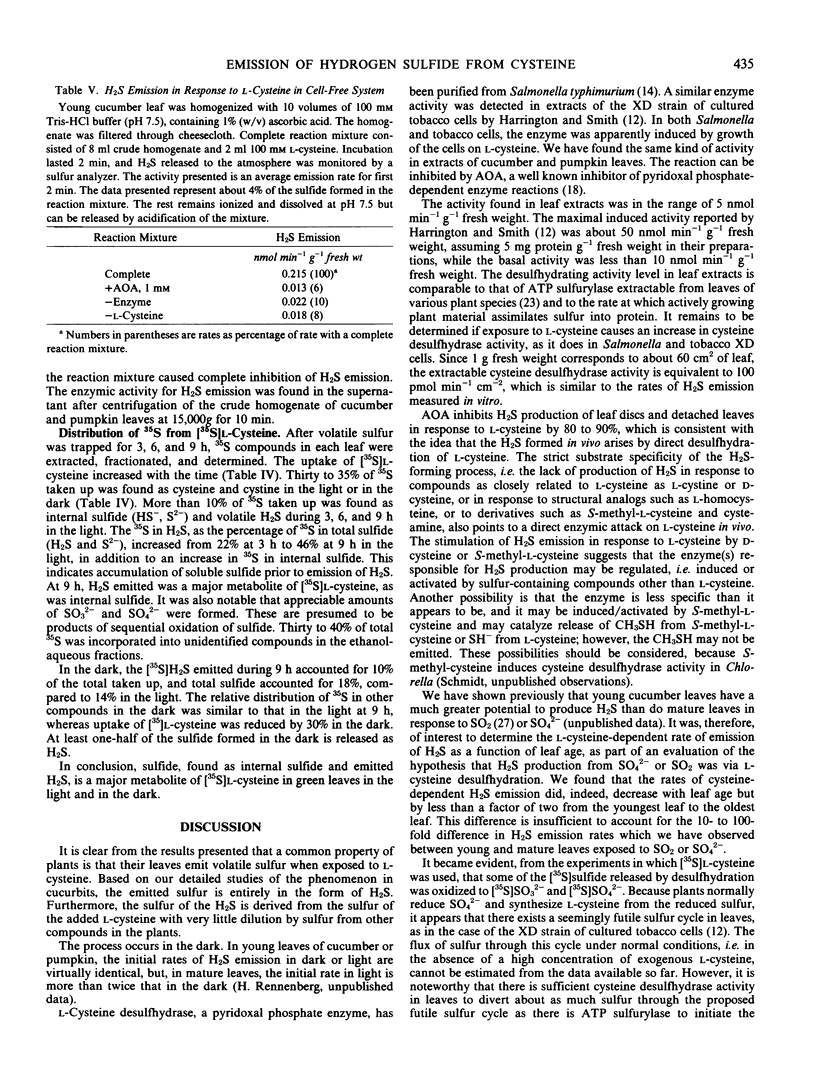Abstract
Leaf discs and detached leaves exposed to l-cysteine emitted a volatile sulfur compound which was proven by gas chromatography to be H2S. This phenomenon was demonstrated in all nine species tested (Cucumis sativus, Cucurbita pepo, Nicotiana tabacum, Coleus blumei, Beta vulgaris, Phaseolus vulgaris, Medicago sativa, Hordeum vulgare, and Gossypium hirsutum). The emission of volatile sulfur by cucumber leaves occurred in the dark at a similar rate to that in the light. The emission of leaf discs reached the maximal rate, more than 40 picomoles per minute per square centimeter, 2 to 4 hours after starting exposure to l-cysteine; then it decreased. In the case of detached leaves, the maximum occurred 5 to 10 h after starting exposure. The average emission rate of H2S during the first 4 hours from leaf discs of cucurbits in response to 10 millimolar l-cysteine, was usually more than 40 picomoles per minute per square centimeter, i.e. 0.24 micromoles per hour per square decimeter. Leaf discs exposed to 1 millimolar l-cysteine emitted only 2% as much as did the discs exposed to 10 millimolar l-cysteine. The emission from leaf discs and from detached leaves lasted for at least 5 and 15 hours, respectively. However, several hours after the maximal emission, injury of the leaves, manifested as chlorosis, was evident. H2S emission was a specific consequence of exposure to l-cysteine; neither d-cysteine nor l-cystine elicited H2S emission. Aminooxyacetic acid, an inhibitor of pyridoxal phosphate dependent enzymes, inhibited the emission. In a cell free system from cucumber leaves, H2S formation and its release occurred in response to l-cysteine. Feeding experiments with [35S]l-cysteine showed that most of the sulfur in H2S was derived from sulfur in the l-cysteine supplied and that the H2S emitted for 9 hours accounted for 7 to 10% of l-cysteine taken up. 35S-labeled SO32− and SO42− were found in the tissue extract in addition to internal soluble S2−. These findings suggest the existence of a sulfur cycle which converts l-cysteine to SO42− through cysteine desulfhydration.
Full text
PDF






Selected References
These references are in PubMed. This may not be the complete list of references from this article.
- Bressan R. A., Lecureux L., Wilson L. G., Filner P. Emission of ethylene and ethane by leaf tissue exposed to injurious concentrations of sulfur dioxide or bisulfite ion. Plant Physiol. 1979 May;63(5):924–930. doi: 10.1104/pp.63.5.924. [DOI] [PMC free article] [PubMed] [Google Scholar]
- Collins J. M., Monty K. J. The cysteine desulfhydrase of Salmonella typhimurium. Kinetic and catalytic properties. J Biol Chem. 1973 Sep 10;248(17):5943–5949. [PubMed] [Google Scholar]
- Collins J. M., Wallenstein A., Monty K. J. Regulatory features of the cysteine desulfhydrase of Salmonella typhimurium. Biochim Biophys Acta. 1973 Jun 20;313(1):156–162. doi: 10.1016/0304-4165(73)90196-7. [DOI] [PubMed] [Google Scholar]
- Ellis R. J. Sulphur metabolism: the usefulness of N-ethylmaleimide. Nature. 1966 Sep 17;211(5055):1266–1268. doi: 10.1038/2111266a0. [DOI] [PubMed] [Google Scholar]
- Esterbauer H., Grill D. Seasonal Variation of Glutathione and Glutathione Reductase in Needles of Picea abies. Plant Physiol. 1978 Jan;61(1):119–121. doi: 10.1104/pp.61.1.119. [DOI] [PMC free article] [PubMed] [Google Scholar]
- Harrington H. M., Smith I. K. Cysteine metabolism in cultured tobacco cells. Plant Physiol. 1980 Jan;65(1):151–155. doi: 10.1104/pp.65.1.151. [DOI] [PMC free article] [PubMed] [Google Scholar]
- Hart J. W., Filner P. Regulation of sulfate uptake by amino acids in cultured tobacco cells. Plant Physiol. 1969 Sep;44(9):1253–1259. doi: 10.1104/pp.44.9.1253. [DOI] [PMC free article] [PubMed] [Google Scholar]
- Kredich N. M., Foote L. J., Keenan B. S. The stoichiometry and kinetics of the inducible cysteine desulfhydrase from Salmonella typhimurium. J Biol Chem. 1973 Sep 10;248(17):6187–6196. [PubMed] [Google Scholar]
- Kredich N. M., Keenan B. S., Foote L. J. The purification and subunit structure of cysteine desulfhydrase from Salmonella typhimurium. J Biol Chem. 1972 Nov 25;247(22):7157–7162. [PubMed] [Google Scholar]
- Meinert M. C., Delmer D. P. Changes in biochemical composition of the cell wall of the cotton fiber during development. Plant Physiol. 1977 Jun;59(6):1088–1097. doi: 10.1104/pp.59.6.1088. [DOI] [PMC free article] [PubMed] [Google Scholar]
- Miller J. M., Conn E. E. Metabolism of hydrogen cyanide by higher plants. Plant Physiol. 1980 Jun;65(6):1199–1202. doi: 10.1104/pp.65.6.1199. [DOI] [PMC free article] [PubMed] [Google Scholar]
- Rando R. R. Irreversible inhibition of aspartate aminotransferase by 2-amino-3-butenoic acid. Biochemistry. 1974 Sep 10;13(19):3859–3863. doi: 10.1021/bi00716a006. [DOI] [PubMed] [Google Scholar]
- Raybould C. C., Unsworth M. H., Gregory P. J. Sources of sulphur in rain collected below a wheat canopy. Nature. 1977 May 12;267(5607):146–147. doi: 10.1038/267146a0. [DOI] [PubMed] [Google Scholar]
- Reuveny Z., Filner P. A new assay for ATP sulfurylase based on differential solubility of the sodium salts of adenosine 5'-phosphosulfate and sulfate. Anal Biochem. 1976 Oct;75(2):410–428. doi: 10.1016/0003-2697(76)90095-6. [DOI] [PubMed] [Google Scholar]
- Reuveny Z., Filner P. Regulation of adenosine triphosphate sulfurylase in cultured tobacco cells. Effects of sulfur and nitrogen sources on the formation and decay of the enzyme. J Biol Chem. 1977 Mar 25;252(6):1858–1864. [PubMed] [Google Scholar]
- Schmidt A. Sulfate reduction in a cell-free system of Chlorella. The ferredoxin dependent reduction of a protein-bound intermediate by a thiosulfonate reductase. Arch Mikrobiol. 1973 Oct 4;93(1):29–52. [PubMed] [Google Scholar]
- Smith I. K. Regulation of Sulfate Assimilation in Tobacco Cells: EFFECT OF NITROGEN AND SULFUR NUTRITION ON SULFATE PERMEASE AND O-ACETYLSERINE SULFHYDRYLASE. Plant Physiol. 1980 Nov;66(5):877–883. doi: 10.1104/pp.66.5.877. [DOI] [PMC free article] [PubMed] [Google Scholar]
- Smith I. K. Sulfate transport in cultured tobacco cells. Plant Physiol. 1975 Feb;55(2):303–307. doi: 10.1104/pp.55.2.303. [DOI] [PMC free article] [PubMed] [Google Scholar]
- Smith I. K., Thompson J. F. Purification and characterization of L-serine transacetylase and O-acetyl-L-serine sulfhydrylase from kidney bean seedlings (Phaseolus vulgaris). Biochim Biophys Acta. 1971 Feb 10;227(2):288–295. doi: 10.1016/0005-2744(71)90061-1. [DOI] [PubMed] [Google Scholar]
- Wilson L. G., Bressan R. A., Filner P. Light-dependent Emission of Hydrogen Sulfide from Plants. Plant Physiol. 1978 Feb;61(2):184–189. doi: 10.1104/pp.61.2.184. [DOI] [PMC free article] [PubMed] [Google Scholar]


